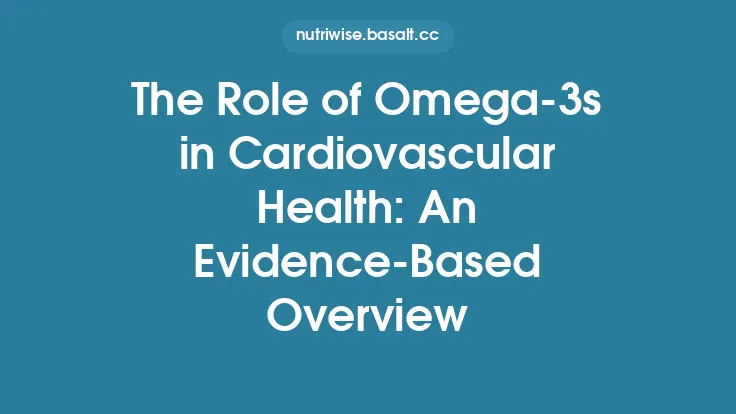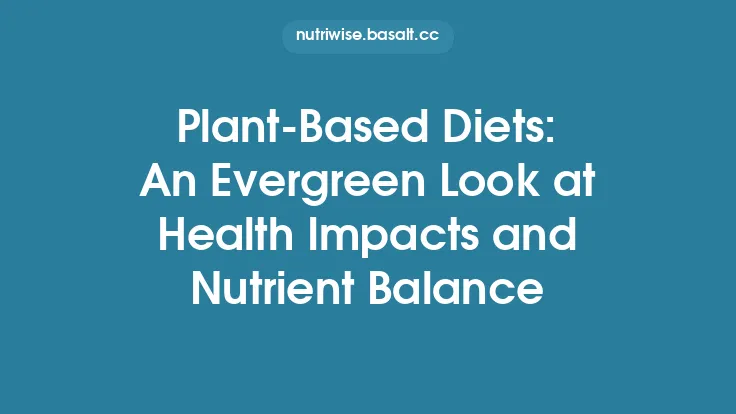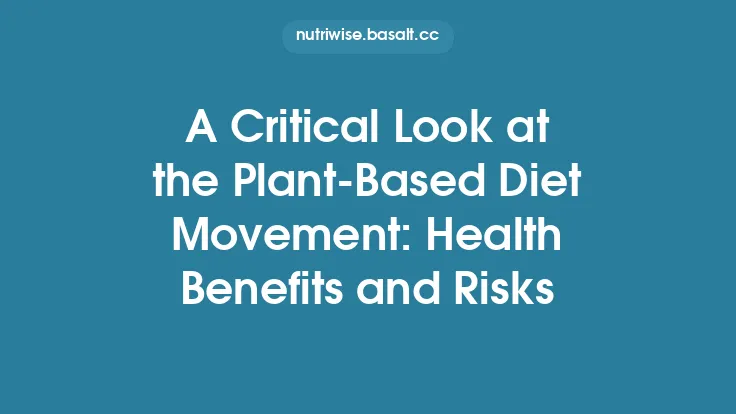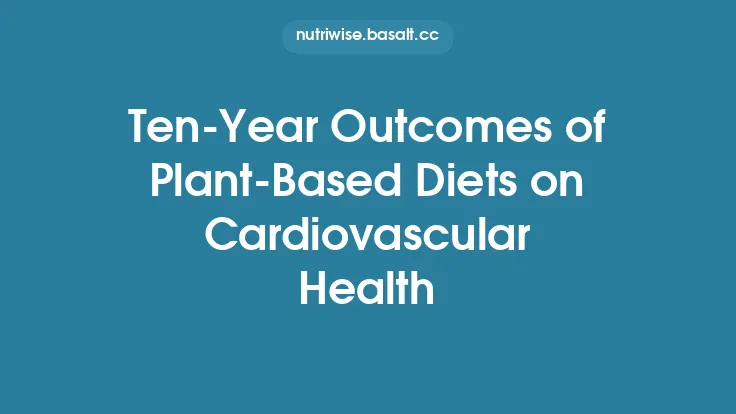Whole‑food plant‑based (WFPB) eating has moved from a niche lifestyle choice to a mainstream dietary pattern that many health professionals recommend for disease prevention and longevity. Unlike broader “plant‑based” labels that can include highly processed meat analogues, sugary drinks, and refined grains, the WFPB approach emphasizes foods that are as close to their natural state as possible: whole fruits, vegetables, legumes, whole grains, nuts, and seeds, with minimal added oils, salts, and sweeteners. This distinction matters because the nutritional composition, bioactive compounds, and overall health impact of minimally processed plant foods differ markedly from those of ultra‑processed alternatives. Below, we examine the current body of scientific evidence on how a WFPB diet influences a range of health outcomes, discuss the biological mechanisms that underlie these effects, and outline practical considerations for adopting this eating pattern safely and sustainably.
Defining Whole‑Food Plant‑Based Eating
| Component | Typical Inclusion | Typical Exclusion |
|---|---|---|
| Fruits & Vegetables | Fresh, frozen, or canned without added sauces or sugars | Fruit juices with added sugar, fruit‑based desserts |
| Legumes | Beans, lentils, peas, soy (edamame, tofu made with minimal processing) | Highly processed soy products (e.g., soy‑based meat analogues with added fats) |
| Whole Grains | Oats, brown rice, quinoa, barley, whole‑wheat pasta | Refined grains, white bread, pastries |
| Nuts & Seeds | Raw or dry‑roasted, unsalted | Salted, honey‑roasted, candied nuts |
| Fats & Oils | Small amounts of whole‑food sources (e.g., avocado, olives) | Added refined oils, butter, margarine |
| Animal Products | Generally excluded; occasional fortified plant milks or yogurts are permissible | Meat, poultry, fish, dairy, eggs |
The emphasis on whole foods means that the diet is naturally high in dietary fiber, micronutrients (e.g., potassium, magnesium, folate), phytochemicals (e.g., polyphenols, carotenoids), and low in saturated fat, cholesterol, and added sugars. These compositional features form the basis for many of the health benefits observed in clinical and epidemiological research.
Methodological Landscape of the Evidence
Research on WFPB eating draws from three primary study designs:
- Randomized Controlled Trials (RCTs) – Short‑ to medium‑term interventions (weeks to years) that directly compare a WFPB regimen with control diets (often standard American or Mediterranean patterns). RCTs provide the strongest causal evidence but are limited by sample size, adherence challenges, and relatively brief follow‑up periods.
- Prospective Cohort Studies – Large population‑based samples followed for 10–30 years, where dietary intake is assessed via food frequency questionnaires and linked to health outcomes. These studies capture long‑term effects but are subject to measurement error and residual confounding.
- Meta‑analyses & Systematic Reviews – Quantitative syntheses that pool data across multiple RCTs or cohorts, increasing statistical power and allowing assessment of consistency across diverse populations.
Across these designs, the most robust findings for WFPB eating pertain to cardiovascular disease, type 2 diabetes, weight management, and certain cancers. Emerging data also suggest benefits for renal health, gut microbiome composition, and mental well‑being, though the evidence base is still evolving.
Cardiovascular Health
Key Findings
- Blood Lipids: Multiple RCTs (e.g., the Ornish program, the BROAD study) have shown that a WFPB diet reduces low‑density lipoprotein cholesterol (LDL‑C) by 15–30 % and triglycerides by 10–20 % without the need for lipid‑lowering medication. A 2022 meta‑analysis of 12 RCTs (n ≈ 1,200) reported a pooled mean reduction of 0.8 mmol/L in LDL‑C compared with control diets.
- Blood Pressure: Whole‑food plant‑based patterns are associated with modest systolic blood pressure reductions (≈ 4–6 mm Hg). The effect is attributed to higher potassium intake, lower sodium density, and improved endothelial function.
- Atherosclerotic Disease: Prospective cohort data (e.g., the Adventist Health Study‑2, > 70,000 participants) demonstrate a 25 % lower risk of coronary heart disease among individuals adhering to a predominantly plant‑based diet, with the greatest risk reduction observed in those consuming the highest quintile of whole‑food plant foods.
Mechanistic Insights
- Fiber & Cholesterol Binding: Soluble fiber (β‑glucan, pectin) binds bile acids in the intestine, promoting their excretion and forcing hepatic conversion of cholesterol into new bile acids, thereby lowering circulating LDL‑C.
- Reduced Saturated Fat & Cholesterol Intake: By eliminating animal fats, the diet naturally reduces dietary cholesterol and saturated fatty acids, both of which up‑regulate hepatic LDL‑C production.
- Polyphenols & Nitric Oxide: Plant polyphenols (e.g., flavonoids, anthocyanins) enhance nitric oxide bioavailability, improving vasodilation and reducing arterial stiffness.
Metabolic Health and Type 2 Diabetes
Key Findings
- Insulin Sensitivity: A 16‑week RCT (n = 84) comparing a WFPB diet to a conventional low‑fat diet found a 30 % improvement in HOMA‑IR (a surrogate for insulin resistance) in the WFPB group.
- Glycemic Control: In patients with established type 2 diabetes, a WFPB intervention led to an average HbA1c reduction of 0.8 % after 6 months, comparable to the effect of first‑line metformin therapy.
- Diabetes Incidence: Cohort analyses (e.g., the EPIC‑Oxford study) report a 20–30 % lower incidence of type 2 diabetes among individuals consuming ≥ 5 servings of whole fruits/vegetables per day and ≤ 1 serving of processed meat per week.
Mechanistic Insights
- Low Glycemic Load: Whole grains and legumes provide slowly digestible carbohydrates, attenuating post‑prandial glucose spikes.
- High Fiber Content: Dietary fiber slows gastric emptying and carbohydrate absorption, reducing the demand for insulin secretion.
- Anti‑Inflammatory Phytochemicals: Chronic low‑grade inflammation contributes to insulin resistance; plant‑derived antioxidants (e.g., quercetin, resveratrol) mitigate inflammatory pathways (NF‑κB, JNK).
Cancer Risk and Progression
Key Findings
- Overall Cancer Incidence: Meta‑analyses of prospective cohorts (n ≈ 1.2 million) reveal a 10–15 % lower risk of all‑site cancer among individuals with high adherence to whole‑food plant‑based patterns.
- Site‑Specific Benefits: Stronger associations are observed for colorectal cancer (≈ 20 % risk reduction) and breast cancer (≈ 12 % reduction), likely reflecting the high fiber and phytonutrient content of the diet.
- Cancer Survivorship: Small pilot trials suggest that a WFPB diet may improve quality of life and reduce recurrence biomarkers (e.g., circulating insulin‑like growth factor‑1) in breast cancer survivors.
Mechanistic Insights
- Fiber‑Derived Short‑Chain Fatty Acids (SCFAs): Fermentation of dietary fiber by gut microbes produces SCFAs (especially butyrate), which promote colonic epithelial health, induce apoptosis in malignant cells, and modulate immune surveillance.
- Antioxidant Capacity: High intake of vitamins C and E, carotenoids, and polyphenols neutralizes reactive oxygen species, reducing DNA damage.
- Hormone Modulation: Phytoestrogens (e.g., isoflavones in soy) can exert weak estrogenic or anti‑estrogenic effects, influencing hormone‑sensitive cancers.
Weight Management and Body Composition
Key Findings
- Energy Density: Whole‑food plant foods are lower in energy density (kcal per gram) than animal‑based or processed foods, facilitating satiety with fewer calories. A 12‑week RCT showed an average weight loss of 5.5 kg in the WFPB group versus 2.1 kg in a standard low‑fat control.
- Long‑Term Maintenance: Observational data from the Adventist Health Study indicate that individuals following a WFPB diet maintain lower body mass index (BMI) over decades, with mean BMI ≈ 23 kg/m² compared with ≈ 27 kg/m² in omnivores.
- Body Fat Distribution: Imaging studies (DXA) demonstrate preferential loss of visceral adipose tissue on a WFPB regimen, which is clinically relevant for cardiometabolic risk.
Mechanistic Insights
- Thermic Effect of Food: Plant proteins and complex carbohydrates have a higher thermic effect than refined carbs and fats, modestly increasing energy expenditure.
- Gut Hormone Modulation: Increased fiber stimulates the release of peptide YY and glucagon‑like peptide‑1 (GLP‑1), hormones that promote satiety and reduce food intake.
Renal and Bone Health Considerations
Renal Health
- Kidney Function: A 2021 systematic review of CKD patients on plant‑dominant diets reported slower decline in estimated glomerular filtration rate (eGFR) and reduced proteinuria, likely due to lower dietary acid load and reduced phosphorus from animal sources.
- Hyperkalemia Risk: While plant‑rich diets are high in potassium, studies show that in individuals with normal renal function, dietary potassium does not translate into hyperkalemia; instead, it may lower blood pressure.
Bone Health
- Calcium & Vitamin D: Whole‑food plant diets can meet calcium needs through fortified plant milks, leafy greens, and legumes. Meta‑analysis data suggest no significant difference in bone mineral density between WFPB adherents and omnivores when calcium intake is adequate.
- Protein Quality: Plant proteins provide sufficient essential amino acids for bone matrix synthesis, especially when a variety of legumes, nuts, and seeds are consumed.
Gut Microbiome and Inflammation
Key Findings
- Microbial Diversity: High‑fiber WFPB diets consistently increase alpha‑diversity and enrich taxa such as *Bifidobacterium and Faecalibacterium prausnitzii*, which are linked to anti‑inflammatory effects.
- Metabolite Profiles: Elevated circulating SCFAs (acetate, propionate, butyrate) have been documented in WFPB participants, correlating with lower C‑reactive protein (CRP) and improved insulin sensitivity.
- Immune Modulation: Reduced endotoxemia (lower lipopolysaccharide‑binding protein) has been observed, suggesting a healthier gut barrier.
Mechanistic Insights
- Prebiotic Fiber: Non‑digestible carbohydrates serve as substrates for beneficial microbes, fostering a symbiotic ecosystem that competes with pathogenic species.
- Polyphenol Metabolism: Gut bacteria transform plant polyphenols into bioactive metabolites (e.g., urolithins) that exert systemic anti‑inflammatory actions.
Mental Health and Cognitive Function
Key Findings
- Depression & Anxiety: Cross‑sectional analyses reveal lower prevalence of depressive symptoms among individuals with high adherence to whole‑food plant‑based diets, even after adjusting for socioeconomic status and physical activity.
- Cognitive Aging: Longitudinal data from the Nurses’ Health Study suggest that higher intake of leafy greens and berries (core components of WFPB) is associated with slower cognitive decline and reduced risk of Alzheimer’s disease.
- Neuroinflammation: Biomarker studies show reduced plasma cytokines (IL‑6, TNF‑α) in WFPB cohorts, supporting a mechanistic link between diet, inflammation, and brain health.
Mechanistic Insights
- Antioxidant Protection: High levels of vitamin E, flavonoids, and carotenoids protect neuronal membranes from oxidative damage.
- Gut‑Brain Axis: SCFAs influence microglial activation and neurotransmitter synthesis, providing a plausible pathway for diet‑driven mood regulation.
Nutrient Adequacy and Supplementation
While a well‑planned WFPB diet can meet most macro‑ and micronutrient needs, certain nutrients warrant special attention:
| Nutrient | Typical Concern | Food Sources (WFPB) | Supplementation Guidance |
|---|---|---|---|
| Vitamin B12 | Not present in plant foods | Fortified plant milks, nutritional yeast | Monthly cyanocobalamin (≥ 250 µg) or daily methylcobalamin (≥ 25 µg) |
| Vitamin D | Limited sun exposure, low dietary intake | Fortified soy/almond milk, UV‑treated mushrooms | 800–2,000 IU/day (D3 from lichen) if serum 25(OH)D < 30 ng/mL |
| Omega‑3 (EPA/DHA) | Low conversion from ALA | Flaxseed, chia, walnuts, hemp | Algal oil supplement (250–500 mg EPA+DHA) |
| Calcium | Variable bioavailability | Kale, bok choy, fortified tofu, fortified plant milks | 1,000–1,200 mg/day from food + supplement if needed |
| Iron | Non‑heme iron less bioavailable | Lentils, chickpeas, pumpkin seeds, quinoa | Pair with vitamin C‑rich foods; consider low‑dose iron supplement only if labs indicate deficiency |
| Zinc | Phytate inhibition | Whole grains, legumes, nuts, seeds | Soak/sprout grains/legumes to reduce phytate; supplement if serum Zn < 70 µg/dL |
Regular monitoring (e.g., annual blood work) helps ensure that any gaps are identified early, especially for B12, vitamin D, and omega‑3 status.
Practical Guidance for Adoption
- Start with a Baseline Assessment – Evaluate current dietary patterns, health markers, and personal goals. Use a simple scoring tool (e.g., Plant‑Based Diet Index) to identify areas for improvement.
- Gradual Transition – Replace one animal‑based meal per day with a plant‑based alternative, progressively increasing the proportion of whole foods while reducing processed plant products.
- Meal Planning Essentials
- Protein: Combine legumes with whole grains (e.g., beans + brown rice) to achieve a complete amino acid profile.
- Variety: Aim for a “rainbow” of colors daily to maximize phytonutrient intake.
- Batch Cooking: Prepare large batches of beans, grains, and roasted vegetables for quick assembly.
- Cooking Techniques – Emphasize steaming, roasting, sautéing with minimal oil, and using herbs/spices for flavor without added sodium.
- Dining Out – Look for menu items centered on salads, grain bowls, or vegetable‑forward plates. Request modifications (e.g., no cheese, extra legumes).
- Social Support – Join community groups, online forums, or cooking classes focused on whole‑food plant‑based cuisine to sustain motivation.
- Track Progress – Use a food diary or app to monitor nutrient intake, especially B12 and vitamin D, and adjust supplementation as needed.
Limitations of Current Research and Future Directions
- Long‑Term RCTs: Most intervention studies span ≤ 2 years. Extended trials are needed to confirm durability of benefits and to assess outcomes such as cancer recurrence and mortality.
- Population Diversity: Existing cohorts are heavily weighted toward North American and European participants, often with higher socioeconomic status. Research in low‑income, non‑Western, and older populations will improve generalizability.
- Standardization of “Whole‑Food” Definition: Variability in how studies define “whole‑food” versus “processed plant” introduces heterogeneity. Consensus criteria would enhance comparability.
- Mechanistic Studies: While associations with gut microbiota and SCFAs are promising, causal pathways linking specific phytochemicals to clinical endpoints remain underexplored.
- Environmental Interactions: Future work should integrate dietary data with environmental exposure (e.g., pollutants, food deserts) to understand real‑world effectiveness.
Bottom Line
A whole‑food plant‑based diet—characterized by minimally processed fruits, vegetables, legumes, whole grains, nuts, and seeds—offers a compelling, evidence‑backed strategy for improving cardiovascular health, metabolic control, cancer risk, weight management, and several other health domains. The benefits stem from a synergistic blend of low saturated fat, high fiber, abundant micronutrients, and bioactive phytochemicals that together modulate lipid metabolism, glycemic response, inflammation, and gut microbiota composition.
When thoughtfully planned, the diet meets nutrient requirements, with targeted supplementation (especially vitamin B12) ensuring completeness. Practical adoption hinges on gradual transition, meal‑prep strategies, and supportive social networks. While more long‑term and diverse research is warranted, the current scientific consensus positions whole‑food plant‑based eating as a safe, sustainable, and health‑optimizing dietary pattern for the majority of individuals.





